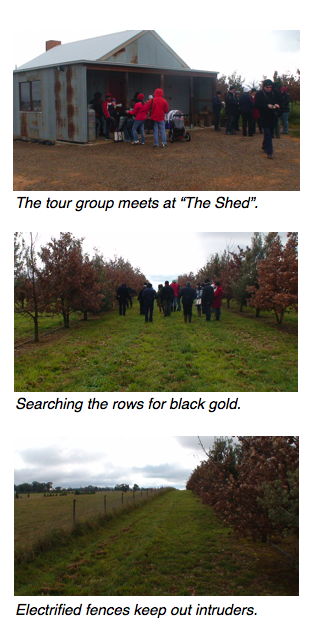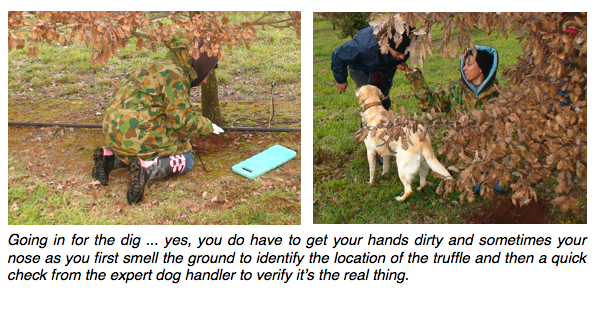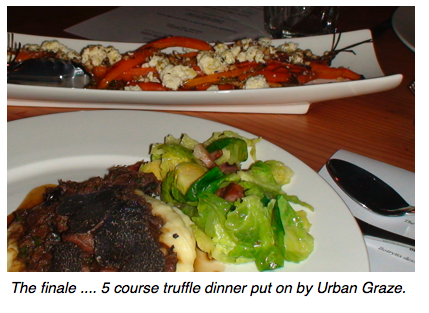 Is it possible to cash in on the lucrative industry of truffle farming from one’s own backyard? That’s the question I began to ask myself after going on a truffle hunting weekend in Millthorpe, NSW.
Is it possible to cash in on the lucrative industry of truffle farming from one’s own backyard? That’s the question I began to ask myself after going on a truffle hunting weekend in Millthorpe, NSW.
In theory, I guess it’s possible if you have the time to wait and you can reproduce the appropriate conditions to cultivate this fungus. Loretto and Greg Good are the farmers at Millthorpe Truffiere and they gave us lots of information on how to cultivate these gourmet delights.
Although I did get the impression that a lot of what they’ve done has been trial and error, with the paddock originating from another one of the family’s “crazy ideas” (they’re actually sheep farmers who planted out 800 trees on speculation, having never grown anything else commercially before).The “Good oil” according to Loretto is getting inoculated tree seedlings and having a go, in typical Aussie style. The Goods picked up some bargain plants for $10 each, usually retailing for $60 each but these overgrown tube-stock plants were destined for the rubbish heap, being root bound and not considered very promising. They bought 3 species, to hedge their bets, and invested in deciduous French and English Oaks and also an evergreen variety Holly Oak, Quercus ilex. At Millthorpe Truffiere it seems that the Holly Oak is producing best quality and quantities of truffles so far. This is a variety better suited to warmer, drier conditions and often used in Spain for that reason.
 Remember you will need the right tree and the right fungus if you’re going to have a fighting chance.
Remember you will need the right tree and the right fungus if you’re going to have a fighting chance.
There are a number of trees you can grow truffles on but they must be able to grow in mycorrhizal symbiosis with the truffle fungus. Hazelnuts have also been used but are sometimes rejected (despite the double crop) because their intricate root system makes the truffles much harder to dig out when harvesting. Yet, some growers believe that the hazelnut host makes for a better quality truffle. Because the root system is deeper, the truffles develop deeper in the soil where temperatures are more constant and buffered against extreme conditions, so the truffles develop gently and consistently.
Tuber melanosporum is the French Black, or Perigord, truffle sought after by chefs. The White Truffle T. magnatum is the king of all truffles, fetching the highest prices but not so widely available. Don’t be fooled into getting inferior stock producing Summer truffles or Chinese truffles, these do not have the same taste or appeal and will not command the same premium dollar if you were to sell them. The fungus and the tree depend upon each other – the fungus provides nutrients for the tree while the tree provides carbohydrates for the fungus, a good arrangement really! Now you need to provide the right conditions for success of both.
Truffles need to avoid real extremes to produce well. The truffle begins to form in Summer and heat or dry conditions during this time can damage it’s development, so irrigation and heavy mulching may be useful if you live in an area that gets less than 700 mm rainfall p.a. Once the truffle has formed then ripened during Autumn ready for harvest in winter, it is similarly important not to let the truffle freeze and ruin it. It’s suggested that 7 good frosts are ideal but certainly continual snow is not. So if you belong to Diggers Club, ideal truffle growing conditions are Heat zone 1-4 and Cold zone 8-10, with good summer rainfall. Truffle farms are being established in Australia in certain parts of Tasmania, Western Australia, Canberra region and central NSW.
Your soil needs to be free draining and with p.H. level of 8. The alkaline conditions seem to eliminate any competition from other mycorrhizal fungus that my be growing in these moist mild conditions. It’s important not to plant your newly inoculated plant near any other hosts like conifers, nuts, oaks or poplars who could potentially carry competing fungus.

I noticed that the Millthorpe farm had their oaks planted very closely together. When I asked about that, it appeared that it is the subject of much debate with some reckoning that close planting helped produce truffles earlier, but once the trees grow and start competing for soil nutrients some are needed to be culled, even if they are producing truffles, to allow them to grow into the large trees that they ultimately become. Others will prefer to simply prune the canopy to restrict the size and allow sunlight through to the soil. Still others will suggest that in natural conditions truffles grow on the outer edge of the forest where there is no competition for light or nutrients, so they will only plant out sparingly, with trees spaced well apart.

The first truffles can be produced from 4 or 5 years after planting for some species (e.g. hazelnuts) to 10 years for other species. It has been the Holly Oak, Q. ilex, that has been the early producer after only 3 years for Millthorpe (perhaps it is more to do with the rich volcanic basalt soils there but who knows) and one Canberra grower produced his first crops on hazelnuts in just 2 years. Some early producing species will produce for up to 20 years, yet later producers are said to still keep going after 50 years. The key is to look for grass dying off underneath the tree, leaving an area brownish in colour and rough on the surface – called brulee, like the dessert, it has a burnt appearance. This indicates fungal activity for the truffle as it kills off other organisms around it.
Electric fencing was also needed at the farm to keep out marauding foxes, rabbits and kangaroos (and I guess wild pigs!) Once exposed, the developing truffle is destroyed so control is critical. Beetles, weevils, snails and slugs also need to be controlled for successful production.
Does it all sound a bit too hard? I guess cultivating anything has its challenges but if you get it right growing truffles can really have it’s rewards. Whether it’s a hobby, a new found interest or the prospect of a future superannuation plan, it is certainly an exciting prospect and an industry that will surely grow here in Australia.





 Twitter
Twitter Facebook
Facebook
Hello Veggie Lady,
I have inherited a property with 114 hazlenut trees which have been innoculated with the truffle spore. The previous owner had these planted about 10 years ago but haven’t had any success. I am not sure why because the property just up the road has had great success – the only difference is that they have Oak trees. Our property is in a cool climate zone in Australia with great volcanic soil with good rainfall. I have measured the soil PH and it shows 6 – 5.5 PH which, according to all the literature, should be around 8 – therefore I need to add lime.
What else do I need to check?
How much lime do I need per square metre?
Do the trees after 10 years of not producing need to be re-innoculated?
Look forward to your advice.
Kind regards, Sandy
Will they grow in maple trees? I live in the PNW foothills to the Olympics
would 1200-1400 meters be 2 high. Have nice deep soils and creek flats. Basalt both red and black, granite / shale and creek flats.
Can truffle trees be grown in Ontario, Canada?
How big is the truffle tree?
Can truffle trees be grown as a bonsai?
Will it bear fruits?
I have bought my first hazelnut tree with truffle spore attached.
I planted it amongst stone pines silver birch and oak trees. Ballarat Victoria.
My question is if the conditions are right will the truffle spores eventually spread to the other trees?
That’s not a certainty and most trees are individually inoculated to ensure success